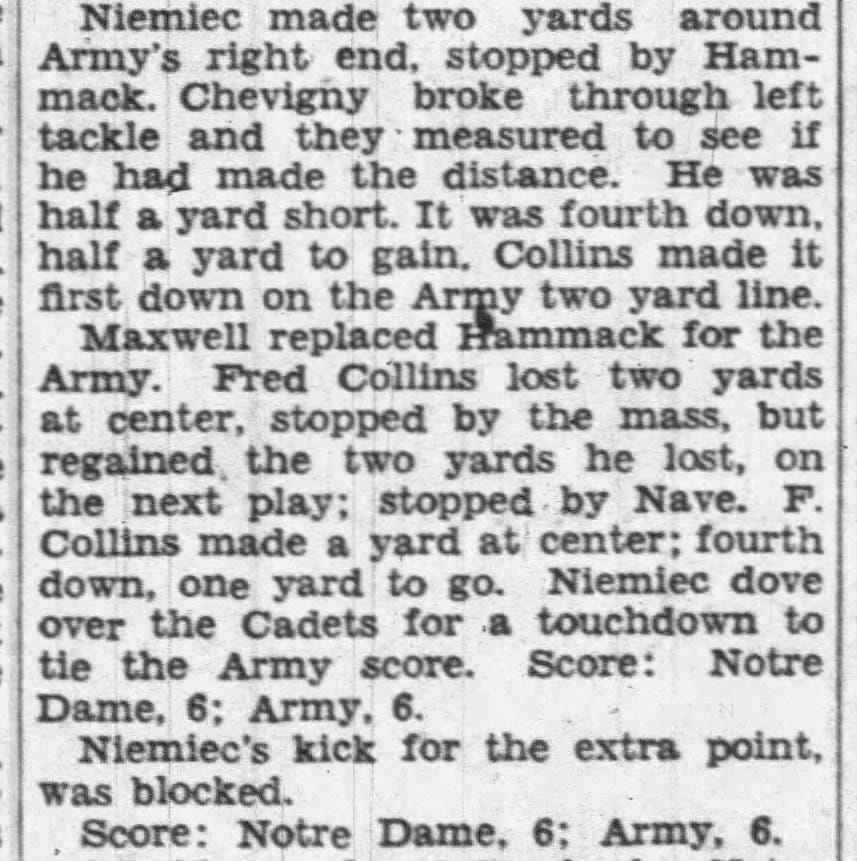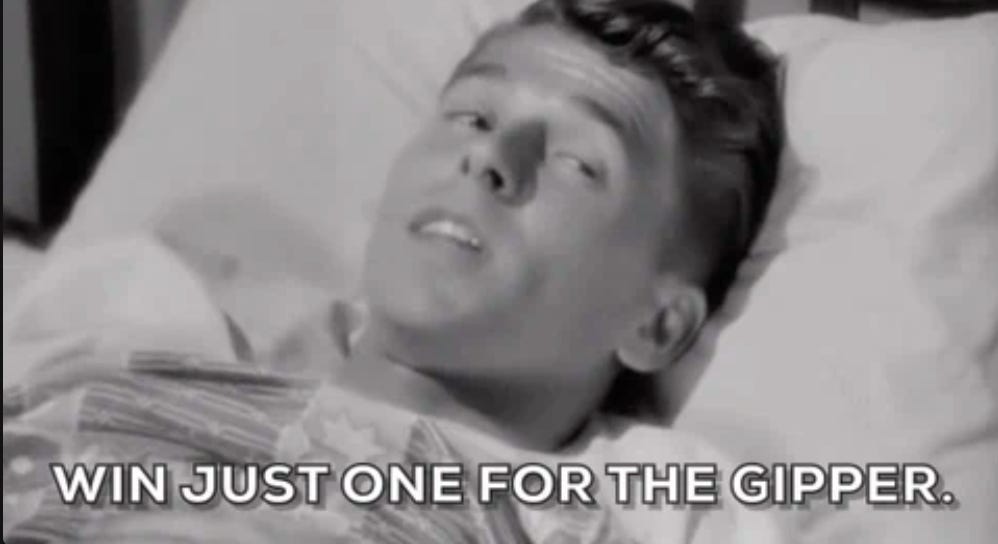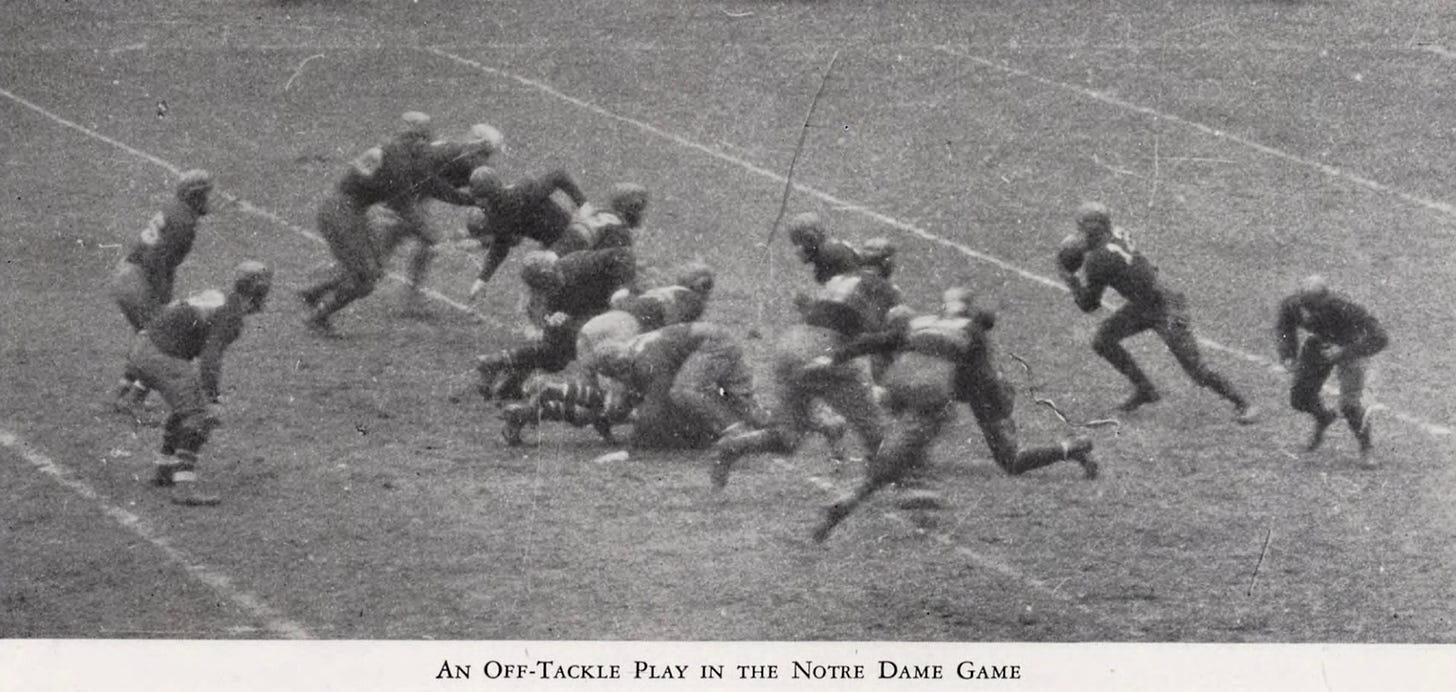Film Room: 1928 Notre Dame-Army "Win One For The Gipper" Game
YouTube provides easy access to old game films that give a sense of what football looked like in the old days. In previous efforts, we reviewed the two oldest known game films.
Since Notre Dame will appear in the National Championship game on Monday, it seemed like this would be a good time to look at moving pictures of the 1928 Notre Dame-Army game, which required a halftime "Win One For The Gipper" speech by Rockne to give the Irish the victory.
Notre Dame entered its 1928 game with Army at 4-2, having lost to Wisconsin and Georgia Tech. Thus, it was not one of Rockne's finest teams. They faced a 6-0 Army team touted as a national championship contender despite playing a weak schedule that included wins over DePauw and Carleton.
The November 10 game saw 78,188 fans crowd into Yankee Stadium, with the military set hoping for a repeat of the 1927 game in which Army gave the Irish their only loss of the season in an 18-0 victory in the Bronx. Notre Dame fans hoped to return the favor that day.
The following provides timestamps with commentary about the game and the nature of football in 1928, emphasizing elements that differ from today. It may be easiest to split your screen and open the article in one window and the YouTube video in another.
The video is choppy and sometimes shows the Army Corps of Cadets marching. It's also black and white, so the teams can sometimes be difficult to distinguish. Notre Dame is on offense much of the time, plus Army's horizontal jersey stripes are apparent at times, while the numbers on the backs of the Notre Dame jerseys are brighter than Army's.
Among the Notre Dame players and numbers to note are:
12 – John Cevigny
18 – John Niemiec
24 – Frank Carideo
26 – Frank Leahy (future ND coach)
44 - Fred Miller (scion and future president of Miller Brewing; All-American tackle)
0:11 Notre Dame is on offense in their Notre Dame Box or Shift, but have the right end and wing spread out. Army's defense often aligns with only one or two players with the hand on the ground. Despite both teams using a lot of misdirection, they run inside the ends most of the time.
0:26 Army is on offense and picks up 18 or so on the first play.
0:51 Army running a sideline play. Note how the tailback drops back to pass and is pinned along the sideline, making scrambling challenging.
0:58 Army runs a QB Sneak, though he does not have his hands under center, as was the norm until the 1940s.
1:21 Army is still on offense. As is the case throughout the game, the pass blocking is quite poor. Since blockers cannot use their hands, the passer comes under pressure quickly.
1:29 Field goal attempt. Army's straight-ahead kicker misses the attempt.
1:40 Only the right tackle on Army's defense has his hand on the ground.
2:08 Corps of Cadets
After halftime, Army scored and missed the extra point attempt to take a 6-0 lead.
2:46 Notre Dame is inside Army's 10-yard line. Note that when they shift, the right end splits out several yards. He fakes the shift on most shifts and returns to a tight position.
Notre Dame fails to score several times but picks up a first down inside the two-yard line before scoring.

4:52 Notre Dame's extra point attempt is blocked, so the game is tied 6-6.
3:40 An example misdirection play run between the tackles
5:05 Army on offense.
5:15 Army drops back on another sideline play with the passer pinned along the sideline. Army's back with the white tape on his pants has a lookout block. The passer throws it up for grabs, it's deflected, and hits the ground. Also, note the official signaling the incompletion using a signal similar to today's intentional grounding. (The officials' signals were not yet standardized.)
5:25 Another weak block attempt by cadet tape-on-his-pants
5:42 Poor pass blocking, including a third weak block by cadet tape-on-his-pants. This play provides a good example of why passing percentages were so low in the 1920s. The inability of blockers to use their hands in the days before cup protection left passers backpedaling on many passes, leading to many passes occurring on rollout and bootlegs.
6:02 Army is on offense. Solid run by Cragle following the shift.
6:10 The film shifts to Notre Dame having the ball. There are only several minutes left in the game. Good gain for the Irish.
6:25 Note the amount of movement at the snap by the linemen and wing, though the wing is stepping backward or parallel.
6:38 Notre Dame has the ball inside the 20-yard line but suffers a bad snap. Chevigny falls on the ball and gets hurt on the play.
6:48 Another pass is thrown up for grabs. After that play, we miss the film of Notre Dame’s Carideo throwing a 30-yard touchdown pass to O'Brien.
6:55 The video shows the aftermath of the Notre Dame touchdown before missing the extra point to take a 12-6 lead. Note the single official under the crossbar signals with one arm that the attempt was not good. (Apparently, he had only one arm.)
7:05 The film catches Chris Cagle in the midst of returning the kickoff. He caught the kick on Army's 25-yard line and returned it 50 yards to Notre Dame's 25-yard line.
7:20 Army runs several plays that do not appear on film before we see them complete a pass to the 10-yard line. Army cannot run another play before the clock runs out, so Notre Dame wins 12-6.
7:35 Several plays from earlier in the game now appear on the film.
8:20 Corps of Cadets
9:35 We see another sideline play. Teams often wasted a play running the ball out of bounds since going out of bounds so the next play would start 10 yards in from the sideline.
Other plays are tacked on at the end. There are no additional comments other than to point out again the pressure passers faced, the poor passing techniques they often exhibit, and their willingness to throw the ball into coverage.
Let me know if you have any comments about the film or my comments about the same.
Thanks to Darin Hayes for suggesting this review!
Click here for options on how to support this site beyond a free subscription.








Great film coverage!